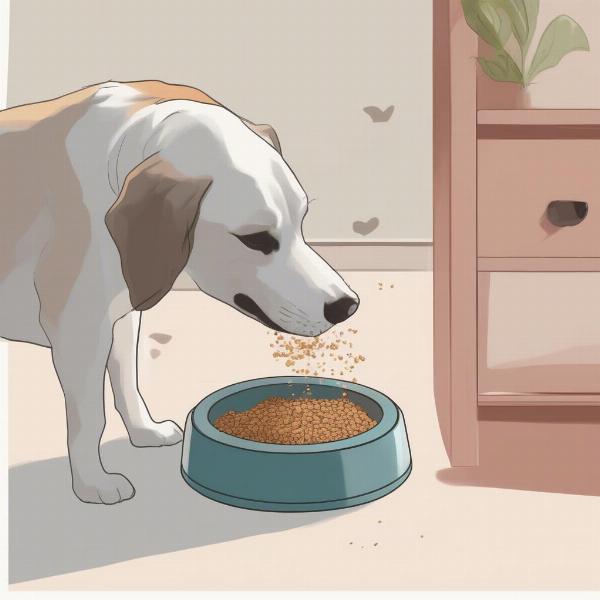Slow feeder dog bowls are designed to do exactly what their name suggests: slow down a dog’s eating. For dogs who gobble their food down in seconds, a slow feeder can be a game-changer, offering a range of benefits from improved digestion to reduced risk of bloat. But with so many options available, finding the perfect dog dish slow feeder can feel overwhelming. This guide will walk you through everything you need to know to choose the best slow feeder for your furry friend.
Understanding the Benefits of a Dog Dish Slow Feeder
Why should you consider a slow feeder? Rapid eating can lead to several problems, including choking, vomiting, and bloat, a life-threatening condition particularly common in larger breeds. By extending meal times, dog dish slow feeders promote better digestion, reduce gas and bloating, and even offer a bit of mental stimulation.
 Benefits of using slow feeder dog bowl
Benefits of using slow feeder dog bowl
Types of Dog Dish Slow Feeders
Slow feeders come in a variety of designs, each with its own pros and cons. Some popular options include:
- Mat-style feeders: These flat mats with raised ridges and grooves are a simple and effective option, perfect for dogs who tend to push their food around. feeder mat for dogs are a great example of this type.
- Bowl-style feeders: These bowls feature various obstacles within the bowl itself, forcing dogs to maneuver their food around. They are typically made of durable materials like plastic or stainless steel.
- Puzzle feeders: These feeders offer a higher level of mental stimulation, requiring dogs to solve puzzles or manipulate parts to access their food.
Choosing the Right Size and Material
Selecting the correct size is crucial for your dog’s comfort. A bowl that’s too small can frustrate your dog, while one that’s too large can defeat the purpose of slowing down eating. Consider your dog’s breed and size when making your choice. Material is another important consideration. Stainless steel is durable and easy to clean, while plastic can be more affordable but may not be as long-lasting.
Introducing Your Dog to a Slow Feeder
Transitioning to a slow feeder should be a gradual process. Start by mixing a small amount of food in the slow feeder with the rest in a regular bowl. Gradually increase the proportion of food in the slow feeder as your dog becomes accustomed to it. For particularly anxious or reluctant dogs, try smearing a thin layer of peanut butter or a lickable treat on the slow feeder to encourage exploration.
How to clean a slow feeder?
Cleaning your dog’s slow feeder regularly is essential to prevent bacteria growth. Most slow feeders are dishwasher safe, but always check the manufacturer’s instructions. For hand washing, use warm soapy water and a brush to reach all the nooks and crannies.
Dr. Emily Carter, a veterinary nutritionist, advises, “Introducing a slow feeder can significantly improve a dog’s digestive health. It’s a simple change with substantial benefits.”
Recognizing When a Slow Feeder Isn’t Working
While slow feeders are generally beneficial, they may not be suitable for every dog. If your dog becomes excessively frustrated or anxious with the slow feeder, it might be necessary to try a different design or return to a regular bowl. Observe your dog’s behavior and consult with your veterinarian if you have any concerns.
Conclusion
A dog dish slow feeder is a valuable tool for promoting healthy eating habits in dogs. By choosing the right type, size, and material, and introducing it gradually, you can help your dog enjoy the numerous benefits of slower eating, from improved digestion to reduced risk of bloat. Remember to consider your dog’s individual needs and preferences to ensure a positive transition to this healthier eating style. hot dog trays can also be a useful addition to your dog’s feeding routine.
FAQ
- Why is my dog eating so fast? Several factors can contribute to fast eating, including competition with other pets, past experiences with food scarcity, or simply an enthusiastic personality.
- Are slow feeders suitable for all breeds? Slow feeders are generally beneficial for most breeds, but certain brachycephalic breeds (those with short noses) might benefit from shallower designs.
- Can puppies use slow feeders? Yes, slow feeders can be introduced to puppies as soon as they start eating solid food. Choose a size and design appropriate for their age and size.
- How often should I clean my dog’s slow feeder? It’s recommended to clean your dog’s slow feeder after every meal, or at least once a day.
- My dog is getting frustrated with the slow feeder. What should I do? Try a different design, such as a mat-style feeder, or make the transition more gradual. 3 bowl elevated dog feeder could be an alternative.
- Can a slow feeder help with weight management? While a slow feeder alone won’t solve weight problems, it can contribute to a healthier eating pace and potentially aid in weight management when combined with a balanced diet and exercise.
- Are there slow feeders for wet food? Yes, some slow feeders are designed specifically for wet food, often with shallower obstacles or mats.
Related Articles:
About ILM Dog
ILM Dog is your one-stop resource for expert advice on dog care, encompassing breed selection, health, training, nutrition, grooming, and accessories. We are dedicated to providing valuable insights and practical tips to help dog owners worldwide provide the best possible care for their canine companions. Whether you’re a seasoned dog owner or just starting your journey, ILM Dog offers a wealth of information to empower you to make informed decisions. Contact us at [email protected] or +44 20-3965-8624 for personalized guidance.